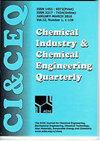Effect of combustion, emission and performance characteristics of hybrid biofuel at different compression ratios
IF 0.8
4区 工程技术
Q4 CHEMISTRY, APPLIED
Chemical Industry & Chemical Engineering Quarterly
Pub Date : 2023-01-01
DOI:10.2298/ciceq230203024a
引用次数: 0
Abstract
The primary aim of this study is to alternate between conventional fossil fuels and reduce the emissions of greenhouse gases and smoke from the diesel engine. The current study aimed to improve the performance and emission characteristics of a VCR diesel engine operated with hybrid biodiesel. Experiments were done with the best hybrid biodiesel, which was made by mixing 20% RSO with 80% WPO. The tests were done at four compression ratios: 16:1, 17:1, 18:1, and 20:1. Under a compression ratio (CR) of 20:1 and at full load, the engine?s brake thermal efficiency went up by 30.5%, its brake-specific fuel consumption went down by 0.347 kg/kW-hr, and notably diminished emissions of carbon monoxide (0.43% volume), hydrocarbons (79 ppm), and smoke (22%). However, with increasing compression ratios, NOx emissions rose unfavourably (1092 ppm) compared to diesel (820 ppm). Also, diesel and clean waste plastic oil were compared to see how the CR values affected combustion, performance, and emissions. Compared to diesel, under maximum load and the CR of 20:1, hybrid biodiesel demonstrated approximately 3.7% higher brake thermal efficiency. The findings suggest potential applications for this hybrid biodiesel in the automobile sector, the power generation industry, and marine applications.不同压缩比下混合燃料燃烧、排放及性能特性的影响
这项研究的主要目的是在传统化石燃料之间进行替代,减少柴油发动机排放的温室气体和烟雾。本研究旨在改善混合生物柴油驱动的VCR柴油发动机的性能和排放特性。以20%的RSO与80%的WPO混合制成的最佳混合生物柴油为实验对象。试验在四种压缩比下进行:16:1、17:1、18:1和20:1。在压缩比(CR)为20:1且满负荷时,发动机?制动热效率提高30.5%,制动油耗下降0.347 kg/kW-hr,一氧化碳(0.43%)、碳氢化合物(79 ppm)和烟雾(22%)排放量显著降低。然而,随着压缩比的增加,氮氧化物排放量(1092 ppm)比柴油(820 ppm)有所增加。此外,还比较了柴油和清洁废塑料油,以了解CR值如何影响燃烧、性能和排放。与柴油相比,在最大负荷和20:1的CR下,混合生物柴油的制动热效率提高了约3.7%。研究结果表明,这种混合生物柴油在汽车行业、发电行业和海洋应用方面具有潜在的应用前景。
本文章由计算机程序翻译,如有差异,请以英文原文为准。
求助全文
约1分钟内获得全文
求助全文
来源期刊

Chemical Industry & Chemical Engineering Quarterly
CHEMISTRY, APPLIED-ENGINEERING, CHEMICAL
CiteScore
2.10
自引率
0.00%
发文量
24
审稿时长
3.3 months
期刊介绍:
The Journal invites contributions to the following two main areas:
• Applied Chemistry dealing with the application of basic chemical sciences to industry
• Chemical Engineering dealing with the chemical and biochemical conversion of raw materials into different products as well as the design and operation of plants and equipment.
The Journal welcomes contributions focused on:
Chemical and Biochemical Engineering [...]
Process Systems Engineering[...]
Environmental Chemical and Process Engineering[...]
Materials Synthesis and Processing[...]
Food and Bioproducts Processing[...]
Process Technology[...]
 求助内容:
求助内容: 应助结果提醒方式:
应助结果提醒方式:


